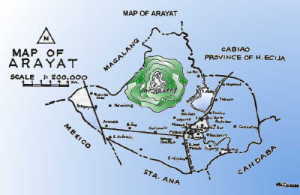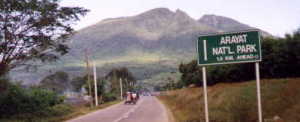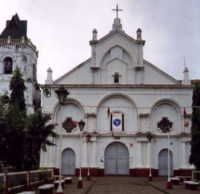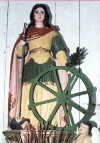Historically speaking, the exact date of Arayat's
foundation is still unknown. Definitely, the town was reported to be one of the thriving
settlements of Pampanga between 1335 to 1380. One chronicler alleges that Prince Balagtas
or his son Araw (Lord) Malangsic (rulers of the Madjapahit empire) was the founder of
Arayat. At that time,it occupied what is today barrio Palinlang and was called Balayan
ning Pambuit. Present-day Poblacion or seat of government was then a wilderness
inhabited by pagan tribes, especially the balugas (Aetas).
Another account mentions such names as Jose Carlos
Garcia,Macapagal, Simbulan, Lapira and Maria Vinas as the early pioneers of Arayat. By
1571, Arayat was one of the eleven most important communities of Pampanga. Because of its
strategic location along the Pampanga River, it became a major center of trade and
commerce - supplying the rice requirements of Manila, the Capital City.
On August 29, 1590, the Augustinians were granted
permission to establish a mission in Arayat by the Bishop of Manila, Fr. Domingo Salazar.
In the same year, the first Augustinian mission in Arayat was founded by Fr. Juan de
Valderrama.
By 1600, the parish of Arayat already existed according to one
historian of the Augustinian order in the Philippines, Elviro Jorde Perez. Available
documents even show that a certain Fr. Contreras was the parish priest of Arayat until
1621. However, it requires further research work to determine whether or not originally
built by the Augustinians. Also, it appears that the first baptism to be recorded at the
parish was performed Fr. Villalobos in 1758.
The town of Arayat is
located in the northern part of Pampanga. It is surrounded by the towns of Magalang on the
northwest, Cabiao on the northeast, Candaba on the East, Sta Ana on the South and Mexico
on the west, with a total area of 17,694 hectares and a population of 90,013 more or less.
Only 19 kilometers away from San Fernando, the
capital town of Pampanga, Arayat is about an hour drive from Manila. The town is the
biggest in northern Pampanga, It is composed of 30 barangays/barrios namely: Arenas, Baliti, Batasan, Buensuceso, Camba (Kaledian), Candating, Cupang, Gatiawin,
Guemasan, La Paz (Turu), Lacmit, Laquios, Mangga-Cacutud, Mapalad, Matamo, Palinlang,
Paralaya, Plazang Luma, Poblacion, San Agustin Norte, San Agustin Sur, San Antonio, San
Jose ( Mesulo), San Juan ( Bano), San Mateo, San Nicolas, San Roque (Bitas), Sto. Nino
(Tabuan), Suklayin, and Telapayong, not to mention subdivisions that sprout outside the
town proper among which are: Fidela, Guemasan, San Nicolas, Aliwalas, Castillo (Bitas),
and Leonor Subdivisions.
Arenas, Baliti, Batasan, Buensuceso, Camba (Kaledian), Candating, Cupang, Gatiawin,
Guemasan, La Paz (Turu), Lacmit, Laquios, Mangga-Cacutud, Mapalad, Matamo, Palinlang,
Paralaya, Plazang Luma, Poblacion, San Agustin Norte, San Agustin Sur, San Antonio, San
Jose ( Mesulo), San Juan ( Bano), San Mateo, San Nicolas, San Roque (Bitas), Sto. Nino
(Tabuan), Suklayin, and Telapayong, not to mention subdivisions that sprout outside the
town proper among which are: Fidela, Guemasan, San Nicolas, Aliwalas, Castillo (Bitas),
and Leonor Subdivisions.
A popular landmark of the town is the majestic
Arayat Mountain or  "Bundok Alaya" . Mount Arayat is likewise
known as Mount Sinukuan, named after legendary Goddess and enchanted lady, Maria Sinukuan
"Bundok Alaya" . Mount Arayat is likewise
known as Mount Sinukuan, named after legendary Goddess and enchanted lady, Maria Sinukuan . It has three peaks, the two highest of which are the Northern Peak with
1086 meters altitude and the Southern Peak with 984 meters height. The Pampanga River has
its bank at the foot of Mt. Arayat. One does not have to climb its summit to see its
natural beauty, for its centrally located in the region, so that one will inevitably enjoy
its splendor as he travel along national highways of Central Luzon.
. It has three peaks, the two highest of which are the Northern Peak with
1086 meters altitude and the Southern Peak with 984 meters height. The Pampanga River has
its bank at the foot of Mt. Arayat. One does not have to climb its summit to see its
natural beauty, for its centrally located in the region, so that one will inevitably enjoy
its splendor as he travel along national highways of Central Luzon.
Situated at the base of the well-known Mount Arayat
is the Mount Arayat National Park, a major tourist attraction not only in Pampanga, but
whole Luzon. It is noted for its swimming pools, wholesome, refreshing and verdant
surroundings and its cool water cascading from its waterfalls.  This Park was
originally a project of Dona Aurora A. Quezon, wife of the late Manuel L. Quezon of the
Philippine Commonwealth, and has been developed into its present state during the post war
era.
This Park was
originally a project of Dona Aurora A. Quezon, wife of the late Manuel L. Quezon of the
Philippine Commonwealth, and has been developed into its present state during the post war
era.
Arayat is generally a level land, except the areas
where Mt. Arayat stands and its vicinities, with a type I climate and two pronounced
seasons; dry from November to April and wet during the rest of the year.
Arayat croplands cover 7,716.49 hectares or about
60% of the total area. It can be also said that it falls within the category of those with
traditional industrial structures as reflected by its lands use, agriculture has the
widest area, followed by forest land, swamp and marshed land. Rice and sugarcane are the
main staple products of the town, followed by corn, mongo, watermelons, turnips, peanuts ,
camote and different kinds of vegetables. Fresh fish are abundant in its rivers and swampy
areas. The forest land of Mount Arayat is the source of firewood, charcoal and the famous
"Teak" wood used in furniture making.
As with the rest of the town of Pampanga, Roman
Catholic remains the dominant religion in Arayat, accounting for more than 90% of the
entire population. Easily over-shadowing all other sects. Iglesia ni Cristo is second
followed by the Aglipayan Church, Seventh Day Adventist, Rizalists, Jehova's Witnesses and
Methodist.
The people of Arayat, although pre-occupied with the
present economic difficulties, are not remiss in their religious obligations. The
Catholics are keeping pace with the demand for more religious facilities and services. The
town old catholic church, St. Catherine Parish , which was built in the
Spanish era, was the object of the recent major renovations vis-à-vis the church proper,
the convent and church patio, through the collective efforts of mandated organizations.
And due to demands of religious services to barangay northwest of the Pampanga River and
to bring such services more accessible to people, the St, Isidore Parish (Camba) was
established by the Archdiocese of San Fernando.
, which was built in the
Spanish era, was the object of the recent major renovations vis-à-vis the church proper,
the convent and church patio, through the collective efforts of mandated organizations.
And due to demands of religious services to barangay northwest of the Pampanga River and
to bring such services more accessible to people, the St, Isidore Parish (Camba) was
established by the Archdiocese of San Fernando.
The education of the youth is still the primordial
concern of the government and the private sectors. There are at present two secondary
schools in the town proper, namely; the old Arayat Institute and the new Berline High
School. Two public high schools are subsidized by the government, Mangga-Cacutud and Camba
Public High Schools, schools cater mostly from barrio youth. All baranggays have their own
elementary school.
The town is not wanting in socio-civic conciousness.
A local chapter of the Philippine Jaycees was organized
the Sinukuan Jaycees and since its inception, it is very active in social and civic
activities. There is also the famous 100 Club- responsible for its civic projects and
annual social affairs at the town plaza.
was organized
the Sinukuan Jaycees and since its inception, it is very active in social and civic
activities. There is also the famous 100 Club- responsible for its civic projects and
annual social affairs at the town plaza.
Like other towns in Pampanga, Arayat has contributed
its just share of prominent and outstanding national figures from the Spanish era to the
present. Northworthy to mention are: General Jose Alejandrino, a contemporary of Jose
Rizal, Dr. Emigdio C. Cruz, of world war II, former executive secretary and ambassador
Amelito R. Mutuc and Press Secretary Leoncio R. Parungao, both of the Macapagal
administration. Not to mention military figures who made their marks in the high echelon
of the Armed Forces of the Philippines, namely: Commodore Lodovigildo L. Gantioqui of the
Philippine Nave, Col. (Ret.) Vicente A. Pascual, former Deputy Judge Advocate Genenral,
Major General Rene R. Cruz, former RaCom V. Commander and PC-INP Deputy Commander for
Administration.
During the last decade, so much has done towards the
improvement of Arayat. The continued threat of lahar during rainy season in the towns of
Minalin, Sto. Tomas, Bacolor, Guagua, and San Fernando, have resulted in the influx of
migration from these towns to Arayat, especially business and commercial establishedments,
which now proliferates in the town proper such as supermarkets, banks, drug stores,
pawnshops and hardware. Indeed, Arayat, has in recent years become the fastest growing
business community.
Arayat is all the more lucky in the face of recent devastating
natural calamities such us the 1990 Killer Earthquake and June 1991 Mt. Pinatubo Eruption,
it being miraculously spared of major damages in lives and properties. The town is lucky
to have as its Patroness, Saint Catherine of Alexandria, in whose loving care and
protection, peace and tranquility among the people reign, despite the modest livelihood of
the people and their varied political and ideological persuasions and beliefs, not to
mention social inequalities. By her benevolent intercession, Arayat continues to be on the
forefront in so far as peace and progress are concerned.